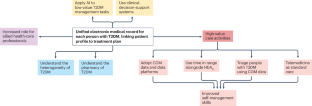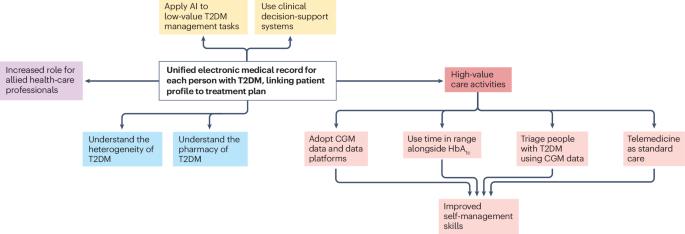2 型糖尿病常规护理中的连续血糖监测
IF 31
1区 医学
Q1 ENDOCRINOLOGY & METABOLISM
引用次数: 0
摘要
尽管连续血糖监测(CGM)设备目前已被视为 1 型糖尿病患者的标准治疗方法,但在 2 型糖尿病(T2DM)患者中的应用却较为缓慢,而且主要集中在接受强化胰岛素治疗的患者身上。不过,现在越来越多的证据支持将 CGM 纳入仅使用基础胰岛素疗法或接受其他药物治疗的 T2DM 患者的常规治疗中。将 CGM 推广到这些人群中,可以最大限度地减少低血糖的发生,同时还能有效地调整和升级疗法。越来越多的随机对照试验和观察性研究表明,CGM 对采用非强化治疗方案的 T2DM 患者具有临床价值。如果进一步的研究证实了这一发现,那么 CGM 很快就会成为 T2DM 常规治疗的一部分。在本视角中,我们探讨了扩大 CGM 在 T2DM 中应用的潜在益处,以及为所有 T2DM 患者提供该技术的循证益处所必须克服的挑战。本文章由计算机程序翻译,如有差异,请以英文原文为准。


Continuous glucose monitoring for the routine care of type 2 diabetes mellitus
Although continuous glucose monitoring (CGM) devices are now considered the standard of care for people with type 1 diabetes mellitus, the uptake among people with type 2 diabetes mellitus (T2DM) has been slower and is focused on those receiving intensive insulin therapy. However, increasing evidence now supports the inclusion of CGM in the routine care of people with T2DM who are on basal insulin-only regimens or are managed with other medications. Expanding CGM to these groups could minimize hypoglycaemia while allowing efficient adaptation and escalation of therapies. Increasing evidence from randomized controlled trials and observational studies indicates that CGM is of clinical value in people with T2DM on non-intensive treatment regimens. If further studies confirm this finding, CGM could soon become a part of routine care for T2DM. In this Perspective we explore the potential benefits of widening the application of CGM in T2DM, along with the challenges that must be overcome for the evidence-based benefits of this technology to be delivered for all people with T2DM. Continuous glucose monitoring (CGM) is an effective tool in the management of diabetes mellitus. This Perspective discusses the potential benefits of widespread adoption of CGM in people with type 2 diabetes mellitus at different stages of disease progression and treatment intensification.
求助全文
通过发布文献求助,成功后即可免费获取论文全文。
去求助
来源期刊

Nature Reviews Endocrinology
医学-内分泌学与代谢
CiteScore
42.00
自引率
0.70%
发文量
158
审稿时长
6-12 weeks
期刊介绍:
Nature Reviews Endocrinology aspires to be the foremost platform for reviews and commentaries catering to the scientific communities it serves. The journal aims to publish articles characterized by authority, accessibility, and clarity, enhanced with easily understandable figures, tables, and other visual aids. The goal is to offer an unparalleled service to authors, referees, and readers, striving to maximize the usefulness and impact of each article. Nature Reviews Endocrinology publishes Research Highlights, Comments, News & Views, Reviews, Consensus Statements, and Perspectives relevant to researchers and clinicians in the fields of endocrinology and metabolism. Its broad scope ensures that the work it publishes reaches the widest possible audience.
 求助内容:
求助内容: 应助结果提醒方式:
应助结果提醒方式:


